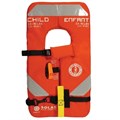Nine in ten boaters who drowned were not wearing a lifejacket or PFD at the time of the incident. Lifejackets save lives.
Lifejackets are a critical aspect to water safety. When boating in Canada, it is the law to have a lifejacket or PFD (personal flotation device) on board for each person on a watercraft, though lifejackets and PFDs only work when you wear them. But beyond boats, wearing a lifejacket around any water is good practice and ensures your family is Water Smart.
What's the difference between a lifejacket and a pfd?
The two terms are often used interchangeably, but there are some key differences. We often refers to both PFDs and lifejackets as lifejackets to make it easier for the public to understand, but it is important to know the differences.
- Lifejackets offer more flotation and have the capability to turn you face-up in the water, even if you’re unconscious.
- PFDs sometimes inflate and must be used and maintained correctly for them to work.
- Lifejackets offer more thermal protection.
- Lifejackets and PFDs are designed for specific activities
- Lifejackets are usually more bulky as they’re for general use, whereas PFDs are often more comfortably designed for specific sport activities.
- PFDs come in specialized designs for a variety of activities including: paddling activities, whitewater activities, power boat activities (tubing, water skiing, etc.).
- They come in different colours and levels of visibility
- PFDs can come in any colour whereas lifejackets only come in red, orange, or yellow for better visibility in water.
- Lifejackets have reflective strips on them
The three types of lifejackets
Safety of Life at Sea (SOLAS) Lifejackets
These ones perform the best in water, turning you on your back within seconds. They only come in the keyhole model, but are available in two sizes: for those over 70lbs (32kgs) or under 70lbs. They’re approved for use on all vessels, but are designed to extend survival in rough, open water where rescue could be slower. These can be foam or inflatable (automatically, manually, or orally inflated).
 Standard Type Lifejackets
Standard Type Lifejackets
These lifejackets are a bit slower to turn you on your back. They’re approved for all vessels except SOLAS vessels and for use on calm, inland water where there is a chance of fast rescue. They also only come in the keyhole model, but are available in two sizes: for individuals over and under 88lbs (40kgs).
Small Vessel Lifejackets
As the name suggests, these lifejackets are approved for small vessels only and designed for use in calm water with a higher chance of fast rescue. They are the slowest at turning you onto your back compared to the other lifejackets. They come in three sizes: for individuals over 90lbs (41kgs), between 40-90lbs, and under 40lbs (18kgs). These lifejackets also come in the keyhole model as well as the vest model.
Inflatable pfds
- Inflatable PFDs come in two approved styles: vest and pouch. Vest styles can inflate automatically, manually, by pulling a toggle, or orally. Pouch styles can be orally or manually inflated by pulling a toggle. Though inflation time for PFDs is short, it could still be too long for a weak swimmer, and using the inflation tube orally that all Canadian-approved PFDs have could be difficult during an emergency.
- Inflatable PFDs are prohibited for:
- children under the age of 16
- anyone who weighs under 80lbs (36.3kgs)
- use on personal watercrafts (e.g., Sea-Doo, Jet Ski)
Tips for Water Smart Parents
- A lifejacket is not a substitute for adult supervision.
- A lifejacket should fit snugly and not ride up over your child’s chin or ears.
- If there are more than 3 inches between your child’s shoulders and the lifejacket, it is too big.
- A large collar is good for supporting your child’s head.
- The safety strap that goes between the legs prevents the lifejacket from slipping over your child’s head.
- Bright colours like red, orange, yellow and pink are reccomended for the best visibility in water.
- The safest lifejackets and PFDs are approved by Transport Canada, the Canadian Coast Guard, or Fisheries and Oceans Canada, which is indicated on the inside label.
- There are no approved lifejackets or PFDs for children under 20lbs. It’s recommended that you wait until your child is over 20lbs before taking them boating. Flotation devices do exist for children under 20lbs, if your child must be on a boat before they are 20lbs, look for these qualities in a flotation vest:
- Large collar/head support
- Handle/grab strap at the top of collar for easier removal from the water if necessary
- Leg straps
- Secure buckles/zippers
- Snug fit